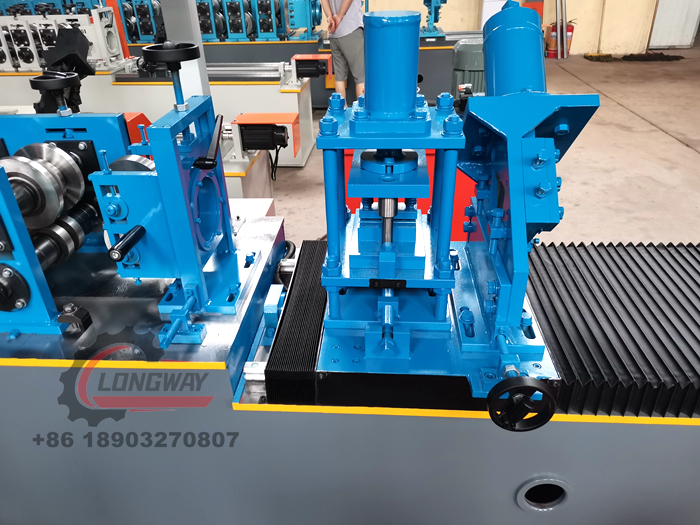Innovative Roll Forming Machine for Efficient Metal Fabrication Solutions
The Evolution and Significance of Roll Forming Making Machines
In the world of manufacturing, efficiency, precision, and innovation are key driving forces behind the production of high-quality products. Among the various methods employed in modern manufacturing, roll forming stands out as a highly efficient and versatile process for creating metal components with complex shapes. Roll forming making machines have revolutionized the industry by offering an effective solution for producing consistent and precise profiles. This article will delve into the intricacies of roll forming machines, their working mechanism, advantages, and applications across various sectors.
Understanding Roll Forming
Roll forming is a continuous bending operation that involves feeding a long strip of metal, usually in coil form, through a series of rolls to achieve the desired cross-section. Unlike stamping or machining processes, roll forming utilizes the gradual deformation of the metal to produce intricate shapes without generating significant waste. This method is particularly effective for producing lengths of material with consistent shapes, making it ideal for industrial applications.
The Components of Roll Forming Making Machines
A roll forming machine typically comprises several key components a decoiler, a roll forming station consisting of multiple roll stations, a cutting station, and a control system.
1. Decoiler The process begins with the decoiler, which unwinds the metal coil and feeds it into the roll forming machine. Proper alignment and tension control are essential to ensure consistent feed rates.
2. Roll Forming Station This is the heart of the machine, where the metal strip is shaped through a series of rollers. Each roller applies a specific amount of pressure to gradually bend the metal to the desired configuration. The design of the roller profile is critical, as it determines the final shape and dimensions of the product.
3. Cutting Station Once the desired length is achieved, the formed metal strips are cut to size. This can be done either through shearing or saw cutting, depending on material thickness and requirements.
4. Control System Modern roll forming machines are equipped with advanced control systems that automate the entire process, ensuring precision and reducing the potential for errors. Programmable logic controllers (PLCs) and human-machine interfaces (HMIs) make it easier for operators to monitor and adjust the machine settings.
Advantages of Roll Forming Machines
The adoption of roll forming technologies offers several advantages over traditional metal fabrication techniques
roll forming making machine

- High Efficiency Roll forming is a continuous process, which means it can produce large volumes of parts rapidly. This efficiency is particularly beneficial for high-demand products.
- Material Savings Since the process minimizes waste by utilizing the entire length of the metal strip, roll forming is a cost-effective solution for manufacturers concerned about material usage
.- Consistency and Precision Roll forming produces components with uniform dimensions, meeting strict tolerances. This consistency is crucial for applications requiring exact specifications.
- Flexibility in Design Roll forming allows for the creation of a wide variety of shapes and sizes, accommodating unique design requirements while maintaining structural integrity.
Applications of Roll Forming Making Machines
Roll forming machines are widely utilized across numerous industries due to their versatility. Common applications include
- Construction Roll-formed steel sections are used in constructing frameworks, roofing, and siding materials.
- Automotive The automotive industry employs roll forming for producing components like chassis parts, window frames, and other structural elements.
- HVAC Heating, ventilation, and air conditioning (HVAC) systems rely on roll-formed ducts and frames for efficient air distribution.
- Furniture The furniture industry benefits from roll forming in the production of metal frames, supports, and decorative elements.
In conclusion, roll forming making machines stand as a testament to the advancements in manufacturing technology. They provide an efficient, consistent, and adaptable method for producing high-quality metal components across various sectors. As industries continue to evolve, it is clear that roll forming will play a significant role in meeting the challenges of modern manufacturing, making it an essential tool for metal fabricators worldwide.
-
Roof Panel Machines: Buying Guide, Types, and PricingNewsJul.04, 2025
-
Purlin Machines: Types, Features, and Pricing GuideNewsJul.04, 2025
-
Metal Embossing Machines: Types, Applications, and Buying GuideNewsJul.04, 2025
-
Gutter Machines: Features, Types, and Cost BreakdownNewsJul.04, 2025
-
Cut to Length Line: Overview, Equipment, and Buying GuideNewsJul.04, 2025
-
Auto Stacker: Features, Applications, and Cost BreakdownNewsJul.04, 2025
-
Top Drywall Profile Machine Models for SaleNewsJun.05, 2025








